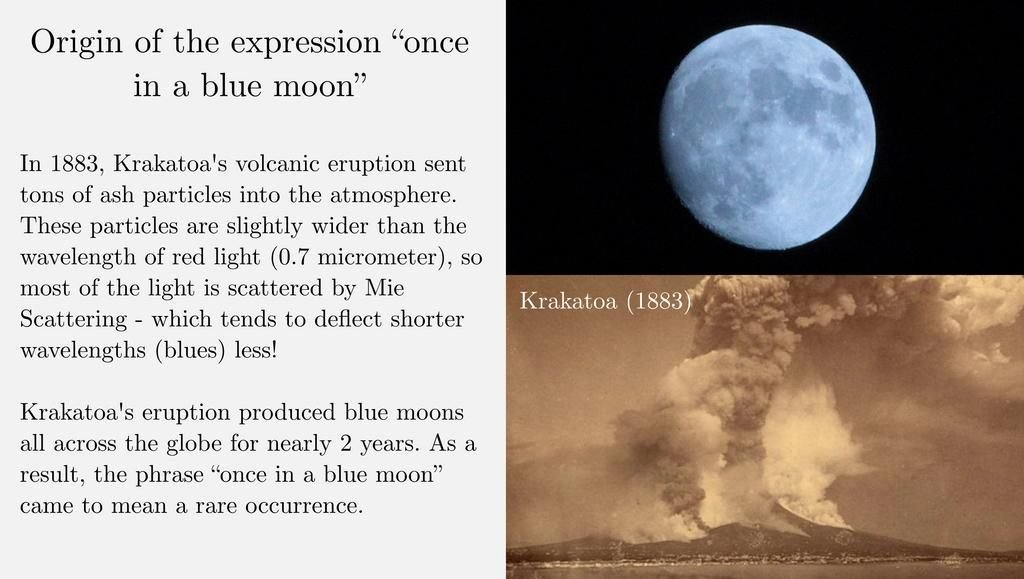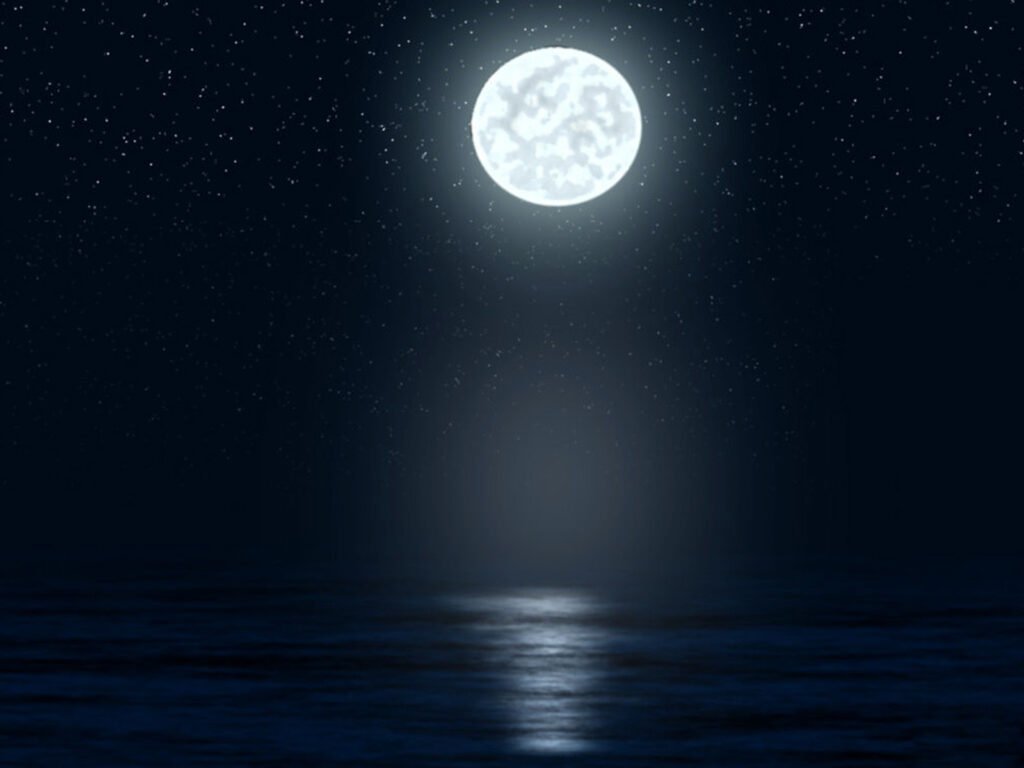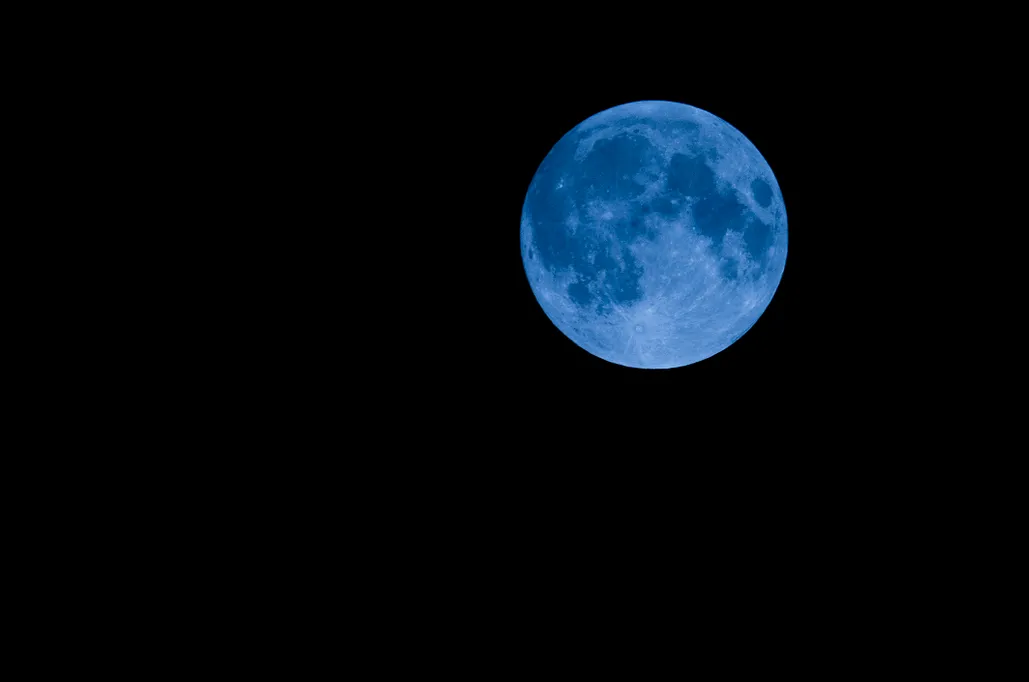Once in a Blue Moon Origin
Once in a blue moon – it’s a phrase we’ve all heard, often used to describe something rare or uncommon. But where does it come from? What’s the story behind this intriguing expression?

Once in a blue moon Origin: Historical Context of the Phrase
The meaning of the expression “once in a blue moon” has changed over time and has a complex history. It was originally used in a ludicrous or impossible way, similar to the expression “when pigs fly.” A comparable expression was first documented in 1528, when it was used to disparage the authority of clergymen1. Eventually, the expression became more literal, alluding to the once-in-a-lifetime event that occurs roughly every 32 months when there is a second full moon in a calendar month. Because of this rarity, the expression is now used to characterize uncommon occurrences1.
It’s interesting to note that in the past, atmospheric phenomena like violent dust storms or volcanic eruptions have caused the moon to seem blue in color. For example, the moon appeared blue for over two years following the Krakatoa eruption in 1883.
The phrase “once in a blue moon” is now frequently used to describe an extremely uncommon, but not impossible, event, similar to the uncommon occurrence of a second full moon in a month2. This statement sums up our love for terms that suggest the wide and unpredictable nature of our planet, as well as our interest with celestial occurrences and the passage of time.
Origin Story
The roots of the term “blue moon” are frequently associated with the strange and magical, and it is steeped in mythology and folklore. Although the meaning of the word has changed throughout time, it originally meant an unforeseen or uncommon occurrence, similar to how uncommon a blue moon is. A blue moon was occasionally interpreted in folklore as an omen or a harbinger of impending major change. It has multiple connotations that have been infused by other cultures: Legends and superstitions: A blue moon was thought to be a time when the barrier separating the realms was the thinnest, allowing for more spiritual energy and magical happenings. It was a moment to rejoice and make plans for the future, or to be cautious of the trickster’s influence.
Songs and Literature: The blue moon has been romanticized in songs and literature, frequently signifying love and a desire for something exceptional and lovely3. Astrology and Astronomy: A blue moon is significant for introspection and personal development in astrology. It is the second full moon of a calendar month or the third full moon of a season with four full moons, according to astronomy.
The extraordinary has been linked to the blue moon since ancient cultures respected the moon and her cycles.
Every year, there are 12 full moons that are named according to the time of year. A “blue moon” is a full moon that occurs too early in the season; the other moons in that year are nonetheless called by their usual seasonal names. Even while the phrase has entered regular usage today to indicate rarity, its mythological and folkloric origins still hold a fascination for us, taking us back to a time when people searched the heavens for miracles and signs. The blue moon remains a symbol of the unexpected and the rare, both in the natural world and in human experience.
Astronomical Significance
Contrary to popular belief, a blue moon isn’t actually blue in color. Instead, it refers to the second full moon that occurs within a calendar month. These events are relatively rare, happening once every few years.
Lunar Cycle: It takes roughly 29.5 days on average for the lunar cycle to go from one full moon to the next. This implies that there will only be one full moon in the majority of months that are longer than this time frame.
Calendar Alignment: Every now and then, the stars line up to produce two full moons in a single calendar month. Some months have thirty or thirty-one days, which gives ample time for two full moons to occur, making this conceivable.

The frequency of blue moons is approximately 41 times per century, or once every 33 months on average. About seven times per 19 years is what this means1.
Monthly versus Seasonal Blue Moons: Actually, there are two kind of blue moons. The term “seasonal blue moon” refers to the third full moon in a season with four full moons in astronomy. The second full moon of a calendar month is the most widely recognized definition (monthly blue moon)2. Historical and Cultural Aspects: The phrase “blue moon” was originally used to refer to extremely unlikely occurrences before it was connected to this uncommon lunar occurrence. As a result, the expression “once in a blue moon” now refers to extremely unusual events.
Real Blue Moons: Although the phrase usually doesn’t allude to the hue, there have been occasions when the moon has seemed blue. The moon may appear blue to the naked eye as a result of meteorological factors like dust storms or volcanic ash that block out red light wavelengths1.
The next monthly blue moon is scheduled for May 31, 2026, and the next seasonal blue moon is anticipated for August 19, 2024. The minimal variations in these dates are contingent upon your time zone2.
In conclusion, the blue moon serves as a reminder of the celestial rhythms that have guided human timekeeping for millennia and is evidence of the fascinating interaction between our calendar system and the moon’s natural cycles.
Cultural Impact
Over the years, the phrase “once in a blue moon” has become ingrained in popular culture. It’s been used in literature, music, and film to evoke a sense of rarity or uniqueness.
Language Evolution
Like many idiomatic expressions, the meaning of “once in a blue moon” has evolved over time. Similar phrases exist in other languages, each with its own cultural connotations.
Scientific Understanding
Today, we understand that a blue moon is simply the result of a quirk in the lunar calendar. It has no special significance beyond its rarity and has been studied extensively by astronomers.
Lunar Cycles: Known as a synodic month, the moon completes its orbit around Earth roughly every 29.5 days. The phases of the moon—from new to full and back—are caused by this cycle.
Gregorian Calendar: Rather than following the lunar cycle, our current calendar, which is solar-based, roughly corresponds to Earth’s orbit around the sun. All months but February have thirty or thirty-one days. The occurrence of a blue moon is when there are two full moons in a single calendar month. This unusual occurrence is conceivable since the moon cycle is shorter than most calendar months. Although there is usually only one full moon per month, there are sometimes circumstances that allow for a second full moon, known as a “blue moon.” Rarity: Because a blue moon only occurs once every 2.5 to 3 years, the expression “once in a blue moon” has come to refer to an uncommon event.

Astronomical Significance: Apart from its rarity, a blue moon has no particular significance in the universe. It has no bearing on the moon’s characteristics or impact on Earth.
Scientific vs. Cultural Perspectives: The scientific perspective is that the blue moon is only an intriguing timing coincidence between the lunar cycle and human calendar, despite the fact that different civilizations may give it mystical or symbolic implications.
In summation, the blue moon is evidence of both the inherent cycles of celestial bodies and the quirks of our timekeeping systems. It is studied by astronomers not for its special qualities but rather to gain a deeper understanding of the lunar cycle and how it relates to the calendar that we use to keep track of time.
Superstitions and Beliefs
Despite its scientific explanation, the phrase “blue moon” still holds a certain mystique. In some cultures, it’s associated with superstitions and beliefs about luck and fortune. Watching and interpreting cosmic events has always piqued human curiosity. Lacking access to science, early cultures frequently gave meaning and force to phenomena they were unable to completely comprehend. The phases of the moon and their impact on tides made the moon a mysterious and amazing object of amazement.
Folklore and Superstitions: Stories to explain the moon’s behavior were woven into folklore and storytelling customs that developed around it. The moon’s appearance was frequently associated with events or results in people’s lives in these passed-down stories. Culture can become embedded with this relationship, even if it is not supported by science.
Tradition’s Power: Science can advance, yet these conventional wisdoms can endure. Although its use has grown, the phrase “blue moon” originally denoted an uncommon third full moon in a season. These days, it can be used to describe any peculiar lunar occurrence, which heightens the mystery. Psychological Elements: There’s the psychological component as well. The human mind looks for relationships and patterns. We could cling to subconsciously held notions when confronted with the uncertainty. This may help to explain why some people continue to connect particular moon phases to good fortune or bad luck. The Mystique of the Unknown
Although science aids in our understanding of the moon’s brightness, we are nonetheless in awe by the vastness of space and the moon’s special place in our solar system. This allows scientific information to coexist with the storytelling and cultural traditions’ strength.
Filling the Void: The gap between tradition and science can be closed with modern methods. It is possible to improve understanding of both the scientific foundation and the cultural importance of the “blue moon” by providing an explanation. The moon may be both a source of scientific wonder and cultural fascination.
Poetic Interpretation
In literature and art, the blue moon has often been used as a symbol of beauty and mystery. Its poetic resonance adds to the allure of the phrase “once in a blue moon.”
Misconceptions
There are many misconceptions surrounding blue moons, including the belief that they’re actually blue in color. In reality, they appear the same as any other full moon.
Modern Usage
Today, the phrase “once in a blue moon” is commonly used to describe anything that happens infrequently or rarely. It’s a versatile expression that’s found its way into everyday speech.
Impact on Language
The enduring popularity of “once in a blue moon” has had a significant impact on the English language. It’s contributed to a rich tapestry of idiomatic expressions that are used to convey rarity or uniqueness.
Celebrations and Events
In some cultures, blue moons are celebrated with special rituals or festivals. These events often involve music, dancing, and other festivities to mark the occasion.
In conclusion, the phrase “once in a blue moon” may have originated from folklore and myth, but its significance extends far beyond superstition. It’s a testament to the enduring appeal of language and the human fascination with the cosmos.
FAQs
- What is the scientific definition of a blue moon?
- A blue moon is defined by science as the second full moon that falls in a single calendar month. This occurs because the lunar cycle lasts for roughly 29.5 days, which sometimes permits the appearance of two full moons in a single month, particularly in those with 31 days.
- How often does a blue moon occur?
- A blue moon occurs approximately once every two to three years. More specifically, a blue moon occurs around once every 33 months, or 41 times every century, or seven times every 19 years.
- Why is it called a “blue” moon?
- The term likely originated from old English, where “blue” was used to mean “rare” or “uncommon.”
- Are there any superstitions associated with blue moons?
- For a considerable amount of time, blue moons have been associated with superstitions and legends, frequently signifying strange or ethereal things. Blue moons are thought to influence human conduct and Earthly events because they are seen as periods of increased spiritual activity in many civilizations. According to certain traditions, a blue moon is a lucky time to embark on new projects or pursue personal development. For some, it’s a time when there’s the least amount of separation between the material world and the spiritual plane, making it easier to communicate with the divine or the paranormal. Certain customs hold that any activity carried out during a blue moon, regardless matter whether it is done with good intent or evil intent, will be magnified. A blue moon is sometimes thought to reconcile former lovers or bring forth unexpected love for those with a romantic bent. From a scientific perspective, a blue moon is only a calendar quirk and has no special meaning, despite its ethereal connections. However, the unusualness of such an occurrence keeps people wondering and speculating, which feeds the collective imagination and perpetuates superstitions.
- Can a blue moon actually appear blue?
- Usually, a blue moon doesn’t appear blue. But in rare instances, meteorological factors like volcanic ash can drastically change how much light passes through, making it appear blue.

